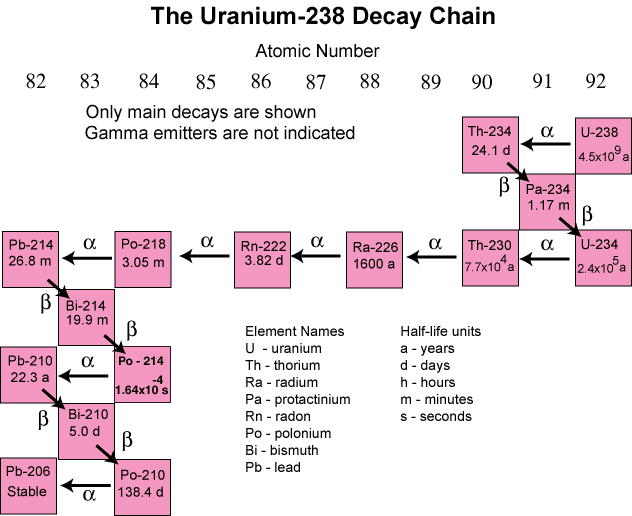
Uranium is a trace element that occurs naturally in the earth's crust. All of the isotopes of uranium are unstable and are radioactive. The most abundant isotopes are 238U and 235U. The percentage abundance of 238U is 99.25 percent and the abundance of 235U is 0.75 percent. According to Adams and Gasparini (1970), in aqueous solutions uranium occurs in the tetravalent ion state under reducing conditions and in the hexavalent state under oxidizing conditions. Under reducing conditions, tetravalent uranium tends to precipitate out or sorb to nearby minerals or organic matter and is not very soluble. Uranium is relatively soluble under oxidizing conditions especially where bicarbonate and other anions are present. Uranium has a large ionic radii, a high coordination number (8) with respect to oxygen, and complete outermost electron shells. Because of its large atomic size, high valence and electronegativity, uranium cannot form isomorphic series that involve major rock forming minerals (such as quartz or feldspar) when an igneous rock is crystalizing from a magma and it thus occurs mostly in accessory minerals. Some of the accessory minerals that often contain uranium are apatite, sphene, zircon, allanite, monazite, pyrochlore, uraninite, and xenotime. Definitions for the various minerals were taken from the second edition of the Glossary of Geology (Bates and Jackson, 1980).
Because uranium is soluble in oxidizing aqueous solutions, it is quite mobile in surface and near surface geologic materials. Surface uranium concentrations, therefore, often exhibit greater variability than potassium or thorium.
The radioactive decay series of 238U is complex and produces alpha, beta, and gamma radiation. The figure below shows the important isotopes in the decay series, indicates whether the primary decay mode is via alpha or beta emission, and gives the half-life.

In addition to the alpha or beta particles emitted as a result of the decay of a parent isotope, most of the daughter isotopes also emit gamma rays. Most of the gamma rays have energies less than 500 keV and cannot be used for gamma-ray spectrometry with NaI(Tl) detectors. 214Bi does produce a number of gamma rays with energies greater than 1.0 MeV and the table below lists the most intense of those gamma rays. Click here to see a graph showing all of the gamma rays.
|
214Bi gamma rays |
|
|
Gamma-ray energy (MeV) |
Relative Intensity (percent) |
|
1.12 |
15.1 |
|
1.16 |
1.6 |
|
1.24 |
5.8 |
|
1.28 |
1.4 |
|
1.38 |
4.0 |
|
1.40 |
1.3 |
|
1.41 |
2.2 |
|
1.51 |
2.1 |
|
1.66 |
1.2 |
|
1.76 |
15.4 |
|
1.85 |
2.1 |
|
2.12 |
1.1 |
|
2.20 |
5.1 |
|
2.45 |
1.6 |
Most gamma-ray spectrometers used for geologic applications measure the intensity of the 1.76-MeV gamma-rays.
[an error occurred while processing this directive]